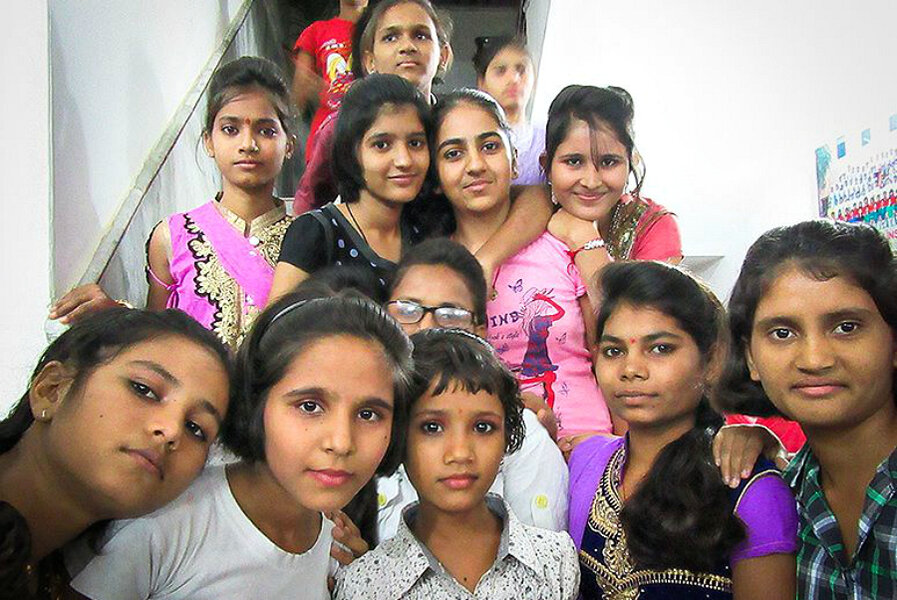A school for child brides delays marriage and provides education
Loading...
Last year, the Veerni Institute received 209 applications for seven vacancies.
That’s because the school is a safe house for child brides in India, a country that has an estimated 240 million child brides, or one-third of the world’s child bride population, according to the United Nations Children’s Fund.
Many of these girls are married off well before the legal age of 18; some are as young as nine or 10. But they’re not sent to their in-laws’ residence until 15 or 16. Even then, they usually don’t attend school in the interim years while they’re still at home.
“We have found a loophole in the system,” says Mahendra Sharma, the director of the Veerni Institute. The gap he’s referring to is the lack of a secondary education for young women who have been married. “We firmly believe that it is of prime importance for all girls to complete senior secondary education in class 12.”
The Veerni Institute is set up as a boarding school, offering not only a place to stay but also health care, daily meals, uniforms, books, computer training, and access to sports. The annual cost for each girl is $1,560. However, the girls attend for free, because the fees are covered by the school’s philanthropic partners: the Global Foundation for Humanity in the U.S. and the Association du Projet Veerni in Switzerland.
Based in Jodhpur, a city in the desert landscape of Rajasthan, 600 kilometers (370 miles) west of New Delhi, the Institute has helped almost 100 girls complete their secondary education. Two-thirds of them have gone on to pursue higher education.
Sharma started working on the project in 2001, four years before the boarding school was established. Instead, during that time, he and his colleagues traveled from village to village. Girls in more than 40 villages received medical care and classes in sewing and artisan work—a means to make a living.
When the Veerni project started setting up literacy centers in these villages, Sharma says it faced some serious resistance.
“Stones were thrown once at the team’s jeep as an expression of anger,” he recalls. “It took a long time to persuade the men to allow their daughters to attend.”
With the help of older women in the community, the men finally came around. But they were not fully convinced.
“The men still insisted that this could not take place in a public area. The lessons should be conducted in one of the village houses,” Sharma says. Only with time did they let the girls leave their homes to go to school in a communal area, away from the watchful eye of their parents and elders.
Despite overcoming these hurdles, Sharma says he wasn’t thrilled with the results of the literacy centers. So he and his colleagues rallied for a boarding house where the girls could devote all their time and energy to their studies.
The first year, Sharma didn’t meet his goal of 60 girls—only 30 girls enrolled. Parents were hesitant to send their daughters away. Yet, after the first year, the same parents were intrigued.
“After seeing our facilities and the quality of our education, the parents trusted us,” Sharma says.
Quickly, the house was at full capacity: 70 girls. One year, it even reached 100 students.
The turning point, Sharma says, is if the parents can see the value of educating their daughters.
“Parents are even sometimes willing to break these marriages if they understand that the girls can now pursue a career and become a source of a steady income to the household,” he says.
Some of the students, though, have used their education to give themselves a new life.
Shoba is an example. Married at the age of nine to a boy in the same village, she graduated from the Veerni Institute and then moved in with her husband as an adult. Her husband turned out to be abusive and a drunk. After falling into a depressive state, she finally reported her husband’s wrongdoings to the local police station. The police called her family, who told her to endure the marriage, despite her husband’s behavior.
Shoba tried another outlet: the legal system. She filed a case, seeking divorce. After one year, her wish was granted. She completed her bachelor’s degree and is now pursuing her master’s, with aspirations of becoming a teacher.
Sharma is hopeful that Shoba’s example will not be the only one.
“We are more and more aware of a change in the mind-set of these villagers and believe that this in itself is an encouraging sign for the future of Indian society,” he says.
Veerni means “brave woman”—a fitting name for such an organization.
• Esha Chhabra is a journalist who covers social enterprise, technology for social impact, and development. This article originally appeared at TakePart, a leading source of socially relevant news, features, opinion, entertainment, and information – all focused on the issues that shape our lives.





